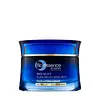What's inside
What's inside
 Key Ingredients
Key Ingredients

 Benefits
Benefits

 Concerns
Concerns

 Ingredients Side-by-side
Ingredients Side-by-side

Water
Skin ConditioningNiacinamide
SmoothingGlycerin
HumectantAlbizia Julibrissin Bark Extract
MaskingDarutoside
Skin ConditioningPalmitoyl Tripeptide-5
Skin ConditioningBetaine
HumectantC14-22 Alcohols
Emulsion StabilisingCaprylic/Capric Triglyceride
MaskingPolyglyceryl-3 Methylglucose Distearate
EmulsifyingHydroxyethyl Acrylate/Sodium Acryloyldimethyl Taurate Copolymer
Emulsion StabilisingIsohexadecane
EmollientSorbitan Isostearate
EmulsifyingEuglena Gracilis Extract
Skin ConditioningTocopherol
AntioxidantCycnoches Cooperi Flower/Leaf Extract
Skin ConditioningHamamelis Virginiana Bark/Leaf/Twig Extract
Skin ConditioningGlycyrrhiza Glabra Root Extract
BleachingRoyal Jelly Powder
Skin ConditioningMethyl Methacrylate Crosspolymer
Carbomer
Emulsion StabilisingXanthan Gum
EmulsifyingDisodium EDTA
Parfum
MaskingPhenoxyethanol
PreservativeWater, Niacinamide, Glycerin, Albizia Julibrissin Bark Extract, Darutoside, Palmitoyl Tripeptide-5, Betaine, C14-22 Alcohols, Caprylic/Capric Triglyceride, Polyglyceryl-3 Methylglucose Distearate, Hydroxyethyl Acrylate/Sodium Acryloyldimethyl Taurate Copolymer, Isohexadecane, Sorbitan Isostearate, Euglena Gracilis Extract, Tocopherol, Cycnoches Cooperi Flower/Leaf Extract, Hamamelis Virginiana Bark/Leaf/Twig Extract, Glycyrrhiza Glabra Root Extract, Royal Jelly Powder, Methyl Methacrylate Crosspolymer, Carbomer, Xanthan Gum, Disodium EDTA, Parfum, Phenoxyethanol
Water
Skin ConditioningButylene Glycol
HumectantGlycerin
HumectantHyaluronic Acid/Polyglutamic Acid Crosspolymer
AntioxidantSodium Hyaluronate
HumectantHydrolyzed Hyaluronic Acid
HumectantHydrolyzed Elastin
EmollientTetrapeptide-5
Skin ConditioningHydrolyzed Collagen
EmollientLactobacillus
Skin ConditioningPhytosteryl Macadamiate
Skin ConditioningPhytosteryl/Octyldodecyl Lauroyl Glutamate
Skin ConditioningSqualane
EmollientDiglycerin
HumectantPullulan
Limnanthes Alba Seed Oil
Skin ConditioningPentylene Glycol
Skin ConditioningPolyquaternium-51
Skin ConditioningIsohexadecane
EmollientXanthan Gum
EmulsifyingCarbomer
Emulsion StabilisingCaprylic/Capric Triglyceride
MaskingPPG-10 Methyl Glucose Ether
Skin ConditioningPolyacrylate Crosspolymer-11
Emulsion StabilisingHydroxyethyl Acrylate/Methoxyethyl Acrylate Copolymer
Polysorbate 60
EmulsifyingAmmonium Acrylates Copolymer
PEG-20 Sorbitan Isostearate
EmulsifyingMelaleuca Alternifolia Leaf Oil
AntioxidantDisodium EDTA
Methylparaben
PreservativeWater, Butylene Glycol, Glycerin, Hyaluronic Acid/Polyglutamic Acid Crosspolymer, Sodium Hyaluronate, Hydrolyzed Hyaluronic Acid, Hydrolyzed Elastin, Tetrapeptide-5, Hydrolyzed Collagen, Lactobacillus, Phytosteryl Macadamiate, Phytosteryl/Octyldodecyl Lauroyl Glutamate, Squalane, Diglycerin, Pullulan, Limnanthes Alba Seed Oil, Pentylene Glycol, Polyquaternium-51, Isohexadecane, Xanthan Gum, Carbomer, Caprylic/Capric Triglyceride, PPG-10 Methyl Glucose Ether, Polyacrylate Crosspolymer-11, Hydroxyethyl Acrylate/Methoxyethyl Acrylate Copolymer, Polysorbate 60, Ammonium Acrylates Copolymer, PEG-20 Sorbitan Isostearate, Melaleuca Alternifolia Leaf Oil, Disodium EDTA, Methylparaben
Ingredients Explained
These ingredients are found in both products.
Ingredients higher up in an ingredient list are typically present in a larger amount.
This ingredient is an emollient, solvent, and texture enhancer. It is considered a skin-softener by helping the skin prevent moisture loss.
It helps thicken a product's formula and makes it easier to spread by dissolving clumping compounds.
Caprylic Triglyceride is made by combining glycerin with coconut oil, forming a clear liquid.
While there is an assumption Caprylic Triglyceride can clog pores due to it being derived from coconut oil, there is no research supporting this.
Learn more about Caprylic/Capric TriglycerideCarbomer is a polymer of acrylic acid. Its main role is to create a gel consistency.
A high amount of carbomer can cause pilling or balling up of products. Don't worry, most products contain 1% or less of carbomer.
Disodium EDTA plays a role in making products more stable by aiding other preservatives.
It is a chelating agent, meaning it neutralizes metal ions that may be found in a product.
Disodium EDTA is a salt of edetic acid and is found to be safe in cosmetic ingredients.
Learn more about Disodium EDTAGlycerin is already naturally found in your skin. It helps moisturize and protect your skin.
A study from 2016 found glycerin to be more effective as a humectant than AHAs and hyaluronic acid.
As a humectant, it helps the skin stay hydrated by pulling moisture to your skin. The low molecular weight of glycerin allows it to pull moisture into the deeper layers of your skin.
Hydrated skin improves your skin barrier; Your skin barrier helps protect against irritants and bacteria.
Glycerin has also been found to have antimicrobial and antiviral properties. Due to these properties, glycerin is often used in wound and burn treatments.
In cosmetics, glycerin is usually derived from plants such as soybean or palm. However, it can also be sourced from animals, such as tallow or animal fat.
This ingredient is organic, colorless, odorless, and non-toxic.
Glycerin is the name for this ingredient in American English. British English uses Glycerol/Glycerine.
Learn more about GlycerinIsohexadecane is added to enhance texture, emulsify, and to help cleanse. It is an isoparrafin. It is a component of petrolatum.
Due to its large size, Isohexadecane is not absorbed by the skin. Instead, it sits on top and acts as an emollient. Emollients help keep your skin soft and smooth by trapping moisture within.
Isohexadecane is often used in products designed to help oily skin. It is lightweight and non-greasy while helping to moisturize. When mixed with silicones, it gives a product a silky feel.
Learn more about IsohexadecaneWater. It's the most common cosmetic ingredient of all. You'll usually see it at the top of ingredient lists, meaning that it makes up the largest part of the product.
So why is it so popular? Water most often acts as a solvent - this means that it helps dissolve other ingredients into the formulation.
You'll also recognize water as that liquid we all need to stay alive. If you see this, drink a glass of water. Stay hydrated!
Learn more about WaterXanthan gum is used as a stabilizer and thickener within cosmetic products. It helps give products a sticky, thick feeling - preventing them from being too runny.
On the technical side of things, xanthan gum is a polysaccharide - a combination consisting of multiple sugar molecules bonded together.
Xanthan gum is a pretty common and great ingredient. It is a natural, non-toxic, non-irritating ingredient that is also commonly used in food products.
Learn more about Xanthan Gum